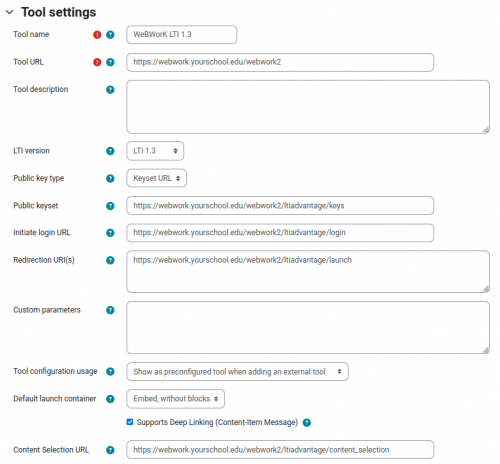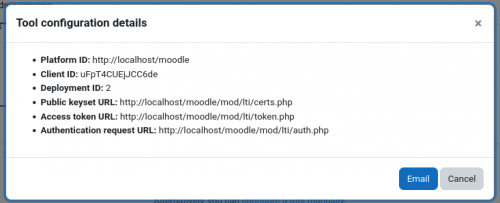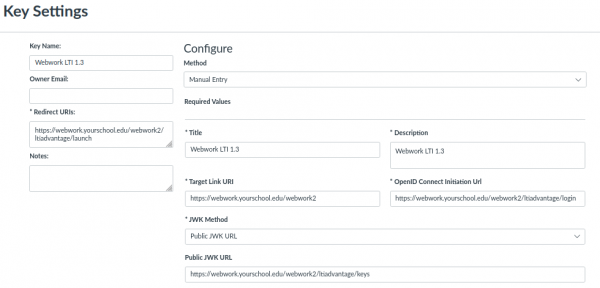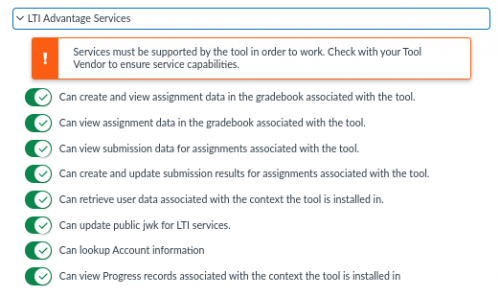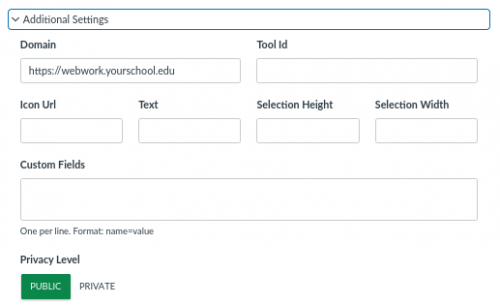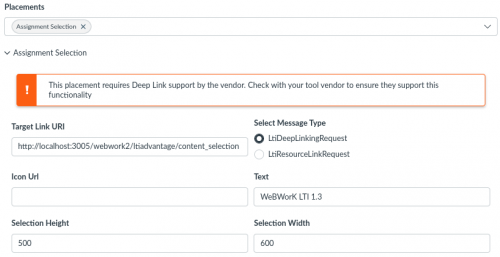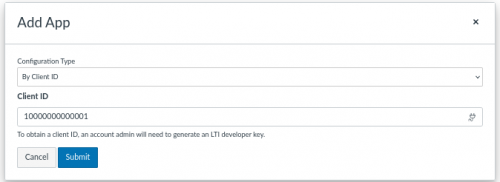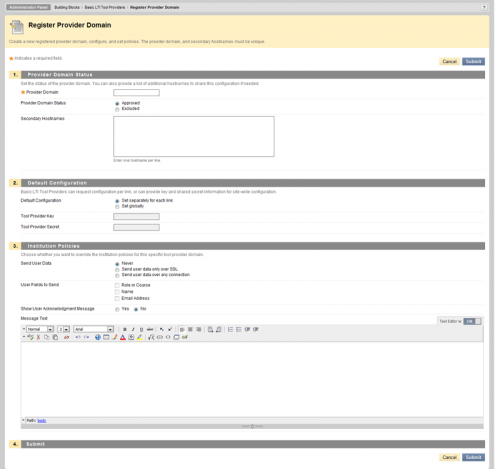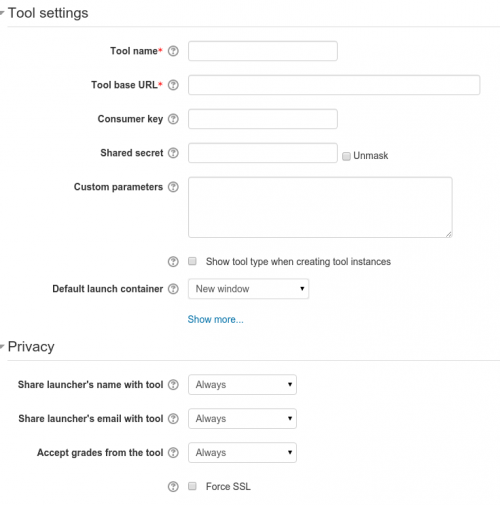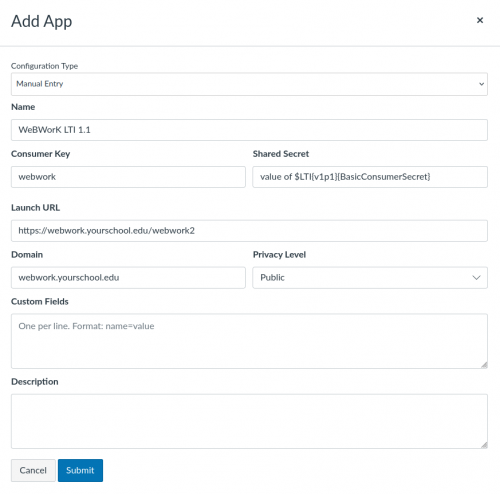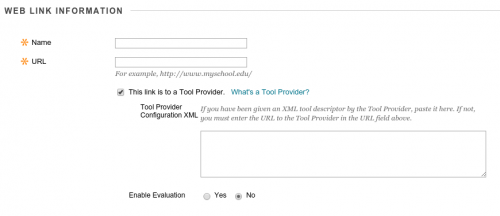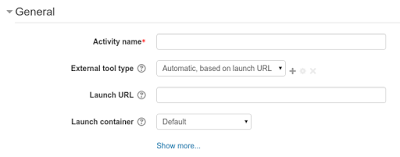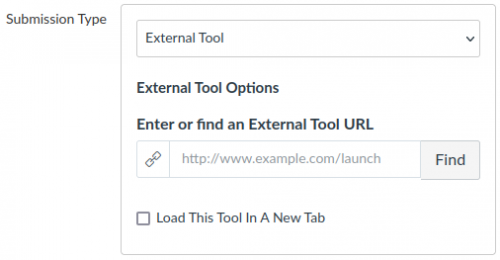LTI Authentication (for WeBWorK 2.18 or newer)
Learning Management Systems (LMS) like Blackboard, Moodle, Canvas, and BrightSpace's Desire2Learn all support a protocol called Learning Tools Interoperability (LTI) which can be used to connect learning tools like WeBWorK to the LMS in a standardized fashion.
This page documents how to setup LTI authentication for WeBWorK 2.18 and beyond. For prior versions of WeBWorK see https://webwork.maa.org/wiki/LTI-Advanced_Authentication.
Contents
LTI Authentication
Before you can use WeBWorK's LTI features you need to do some initial setup. This will need to be done by a system administrator and in particular often requires administrator access to both WeBWorK and your Learning Management System.
First Time WeBWorK Setup
Start by making a copy of the distribution configuration file needed with the following command.
cp /opt/webwork/webwork2/conf/authen_LTI.conf.dist /opt/webwork/webwork2/conf/authen_LTI.conf
In localOverrides.conf uncomment the line that reads #include("conf/authen_LTI.conf"); by removing the # from the beginning of the line.
Now determine which version of LTI you will be using, either LTI 1.1 or LTI 1.3. Note that both versions can be used by one WeBWorK server for different courses if needed.
If you will be using LTI 1.1, then uncomment the line in authen_LTI.conf that reads #include('conf/authen_LTI_1_1.conf'); by removing the # from the beginning of the line and copy the LTI 1.1 distribution configuration file with
cp /opt/webwork/webwork2/conf/authen_LTI_1_1.conf.dist /opt/webwork/webwork2/conf/authen_LTI_1_1.conf
If you will be using LTI 1.3, then uncomment the line in authen_LTI.conf that reads #include('conf/authen_LTI_1_3.conf'); by removing the # from the beginning of the line and copy the LTI 1.3 distribution configuration file with
cp /opt/webwork/webwork2/conf/authen_LTI_1_3.conf.dist /opt/webwork/webwork2/conf/authen_LTI_1_3.conf
Note that all WeBWorK LTI configuration variables that do not have a $LTI{v1p?} prefix are in the authen_LTI.conf file, and are used by both versions of LTI. All variables that have the $LTI{v1p1} prefix are in the authen_LTI_1_1.conf file, and are only used by LTI 1.1. All variables that have the $LTI{v1p3} prefix are in the authen_LTI_1_3.conf file, and are only used by LTI 1.3.
The followed are the variables defined in authen_LTI.conf. Some of these are described in more detail later in this document.
- $debug_lti_parameters: Set this to 1 to enable debugging. Getting LTI authentication set up can be tricky, and this can with troubleshooting the issues. Note that for LTI 1.1 most of these messages are displayed in the browser, but for LTI 1.3 you will need to inspect the
logs/webwork2.logfile to see the error messages. Make sure to set this back to 0 for production use.
- $debug_lti_grade_passback: Set this to 1 to get debugging information when using grade pass back. As with the previous option, the messages for LTI 1.1 are displayed in the browser, but most LTI 1.3 messages will be in the
logs/webwork2.logfile. Make sure that this is also set to 0 for production use.
- $authen{user_module}: This is a list of authentication modules in the order that they will be considered when a request is received by WeBWorK. Usually you will not need to modify this from the default values.
- $authen{admin_module}: This is a list of authentication modules tha are allowed for signing in to the admin course. By default only "WeBWorK::Authen::Basic_TheLastOption" is allowed, which means that only username and password sign in is allowed. If you want to allow signing in to the admin course via LTI, then you can uncomment "WeBWorK::Authen::LTIAdvantage" (for LTI 1.3) or "WeBWorK::Authen::LTIAdvanced" (for LTI 1.1). This is not recommended.
- $LTIVersion: Set this to the LTI version that the courses on your server will be using. This is either "v1p1" for LTI version 1.1, or "v1p3" for LTI version 1.3. This can also be set in a course's course.conf file to make a course use a different LTI version than the site wide default.
- $LTIAccountCreationCutoff: WeBWorK will automatically create users when logging in via the LMS for the first time for users with a permission level below what this is set to. This is set to "ta" by default.
- $LMSManageUserData: If set to 1 (the default setting), then WeBWorK's user demographic data will be kept up to date with the data from the LMS.
- $external_auth: If set to 1, then the username and password fields will not be displayed on the WeBWorK login page. Instead a message will be shown informing users to sign in via the LMS. This is set to 0 by default.
- $LTIGradeMode, $LTIGradeOnSubmit, $LTICheckPrior, and $LTIMassUpdateInterval: These are for grade passback. Details on these will be given later in this document.
- @LTIConfigVariables: If any of the listed variables are uncommented, then an "LTI" tab will be available on the "Course Configuration" page in courses. The settings for the uncommented variables can be changed for an individual course by the instructor in that tab.
Next follow the instructions for the LTI versions that will be used by your server below.
LTI 1.3 Setup
LTI 1.3 LMS Configuration
First the LMS needs to be configured to use LTI 1.3 authentication. Follow the instructions for your LMS below.
Moodle
Set the external tool configuration settings as shown in the screen shots below. Make sure to change https://webwork.yourschool.edu to the URL for your webwork2 server. You can use a different "Tool name" and add a "Tool description" that is appropriate for you. Note that the "Content Selection URL" is needed for version 4.02 or newer of Moodle in order for instructors to add WeBWorK assignment links to their courses. Make sure to follow the instructions for this later in this document. Older versions of Moodle allow manual link creation.
View the configuration details for the external tool that is created after saving the changes by clicking on the list icon in the top right corner of the created tool. It will look something like the following screenshot. Save these details for the WeBWorK configuration later.
The shown values in the order shown will be the values for the variables $LTI{v1p3}{PlatformID}, $LTI{v1p3}{ClientID}, $LTI{v1p3}{DeploymentID}, $LTI{v1p3}{PublicKeysetURL}, $LTI{v1p3}{AccessTokenURL}, and $LTI{v1p3}{AuthReqURL}, respectively, in the authen_LTI_1_3.conf file. The "Access token URL" will also be the value for the $LTI{v1p3}{AccessTokenAUD} variable.
Canvas
First, a user that has admin privileges in Canvas must create a developer key. On the developer keys page click "+ Develop Key" and select "LTI Key". Set the key settings as shown in the following screen shots. Make sure to change https://webwork.yourschool.edu to the URL of your server. You can use a "Key Name", "Title", and "Description" that are appropriate for you.
Note that some of the following services may not be needed, but I am not sure which ones are so just check them all!
Under "Additional Settings" add the "Domain" of your WeBWorK server and make sure the "Privacy Level" is set to "PUBLIC".
Add the "Assignment Selection" placement as shown below if you want to be able to utilize content selection. You can remove any other placements. WeBWorK does not support any of the others at this time.
After saving the developer key you will see the following. Make note of the long number above the "Show Key" button in the details column. That is the client id which will be needed in the next step and will be the value for the $LTI{v1p3}{ClientID} in the WeBWorK authen_LTI_1_3.conf file.
Now go to "Settings" and select the "Apps" tab. Click on "+ App" and select "By Client ID" for the "Configuration Type". Enter the client id from above as shown below. Then click "Submit".
After submitting Canvas will return to the "Apps" tab in "Settings". Find the app you just created and click on the gear icon drop down menu to the right. Select "Deployment ID" and save the deployment ID that is shown. This will be the value for the $LTI{v1p3}{DeploymentID} in the WeBWorK authen_LTI_1_3.conf file.
The other variables that will need to be set in the authen_LTI_1_3.conf file are as follows:
- $LTI{v1p3}{PlatformID}: Either 'https://canvas.instructure.com' or 'https://yourschool.instructure.com' (It is not known at the time of this writing which this will need to be in production.)
- $LTI{v1p3}{PublicKeysetURL}: 'https://yourschool.instructure.com/api/lti/security/jwks'
- $LTI{v1p3}{AccessTokenURL}: 'https://yourschool.instructure.com/login/oauth2/token'
- $LTI{v1p3}{AccessTokenAUD}: 'https://yourschool.instructure.com/login/oauth2/token'
- $LTI{v1p3}{AuthReqURL}: 'https://yourschool.instructure.com/api/lti/authorize_redirect'
Brightspace (D2L)
A post about LTI 1.3 for Brightspace (D2L) appears at https://sukhjitsehra.github.io/webwork-2.18/.
LTI 1.3 WeBWorK Configuration
Now configure WeBWorK for LTI 1.3 authentication.
In the authen_LTI_1_3.conf file set the LTI 1.3 basic authentication parameters $LTI{v1p3}{PlatformID}, $LTI{v1p3}{ClientID}, $LTI{v1p3}{DeploymentID}, $LTI{v1p3}{PublicKeysetURL}, $LTI{v1p3}{AccessTokenURL}, $LTI{v1p3}{AccessTokenAUD}, $LTI{v1p3}{AuthReqURL} to the values found in the LMS configuration above.
Set $LTIVersion = 'v1p3'; in authen_LTI.conf. You may instead set this in the course.conf files of the courses that you want to use LTI 1.3 for, leave $LTIVersion = 'v1p1'; in authen_LTI.conf if most of the courses on your server will be using LTI 1.1.
There are some other options that can be set as well. Some of these are discussed in more detail in other sections of this document.
- $LTI{v1p3}{LMS_name}: This is a string that is used to name the LMS for end users. It is used in messages displayed for users by WeBWorK.
- $LTI{v1p3}{LMS_url}: This is a URL that should take users to a place they can log in to their LMS. It is also used in messages displayed for users by WeBWorK together with the LMS_name above.
- $LTI{v1p3}{preferred_source_of_username}: When a user logs into WeBWorK from the LMS WeBWorK needs to determine the username of the person logging in. This determines which parameter sent from the LMS to use for the WeBWorK username. This is "email" by default, but can be set to any parameter included in the JWT sent from the LMS that uniquely identifies users.
- You can set $debug_lti_parameters = 1 in
authen_LTI.confto help find which parameter to use for this. - If this variable is set to "email", then by default the entire email address is used. If you don't want to use the entire email address you can also set $LTI{v1p3}{strip_domain_from_email} = 1 and WeBWorK will remove the domain name from the email address when creating the username.
- You can set $debug_lti_parameters = 1 in
- $LTI{v1p3}{fallback_source_of_username}: If the parameter set for $LTI{v1p3}{preferred_source_of_username} is not present in the JWT sent from the LMS, then the parameter set for this variable will be used instead if it is present in the JWT. This is not set by default.
- $LTI{v1p3}{lowercase_username}: If set to 1, then all usernames (as determined by the options above) will be converted to lowercase.
- $LTI{v1p3}{preferred_source_of_student_id}: The parameter sent from the LMS to use for the WeBWorK student id. This is optional and is not set by default.
- You can set $debug_lti_parameters = 1 in
authen_LTI.confto help find which parameter to use for this.
- You can set $debug_lti_parameters = 1 in
- $LTI{v1p3}{StateKeyLifetime}: When the WeBWorK responds to an initial LMS request it includes state and nonce values in that request. These values are saved in the database until the response from the LMS to that request is received. This variable controls how long in seconds this data will be saved in the database before it is considered stale and deleted. It should be short enough to accomodate normal server and networking delays. Note that if authentication is successful this will be deleted before this lifetime expires in any case. This is only to ensure that keys from failed authentication attempts don't pile up in the database.
- $LTI{v1p3}{LMSrolesToWeBWorKRoles}: This is a mapping of roles used by the LMS to WeBWorK roles. Add roles to this if your LMS uses a role that is not present in the mapping already.
- $LTI{v1p3}{modify_user}: This can be set to a routine that can modify the student id and other user data when a user signs in from the LMS.
- $LTI{v1p3}{modify_user_set}: When users are added to the system they are also assigned all visible sets. This can be set to a routine that can modify the sets before they are assigned.
LTI 1.1 Setup
LTI 1.1 WeBWorK Configuration
In authen_LTI_1_1.conf set $LTI{v1p1}{BasicConsumerSecret}. This acts like a global password and is used to authenticate all communication between WeBWorK and the LMS. So pick something secure.
Set $LTIVersion = 'v1p1'; in authen_LTI.conf (this is the default setting). You may instead set this in the course.conf files of the courses that you want to use LTI 1.1 for, and set $LTIVersion = 'v1p3'; in authen_LTI.conf if most of the courses on your server will be using LTI 1.3.
There are some other options that can be set as well. Some of these are discussed in more detail in other sections of this document.
- $LTI{v1p1}{LMS_name}: This is a string that is used to name the LMS for end users. It is used in messages displayed for users by WeBWorK.
- $LTI{v1p1}{LMS_url}: This is a URL that should take users to a place they can log in to their LMS. It is also used in messages displayed for users by WeBWorK together with the LMS_name above.
- $LTI{v1p1}{preferred_source_of_username}: When a user logs into WeBWorK from the LMS WeBWorK needs to determine the username of the person logging in. This determines which parameter sent from the LMS to use for the WeBWorK username. This can be lis_person_sourcedid, lis_person_contact_email_primary (the default), or another parameter sent from the LMS that uniquely identifies users. This setting is required.
- If this variable is set to "lis_person_sourcedid" then the sourced_id will be used as the WeBWorK username. Note: The LMS may not provide this parameter, and if it is provided it is usually an obscure identifier that is likely not a good choice for a username.
- If this variable is set to "lis_person_contact_email_primary" then the email address provided by the LMS will be used for the WeBWorK username.
- By default the entire email address is used. If you don't want to use the entire email address you can also set $LTI{v1p1}{strip_domain_from_email} = 1 and WeBWorK will strip off the server portion of the email address when creating the username.
- You can set $debug_lti_parameters = 1 in
authen_LTI.confto help find which parameter to use for this.
- $LTI{v1p1}{fallback_source_of_username}: If the parameter set for $LTI{v1p1}{preferred_source_of_username} can not be found, then the parameter set for this variable will be used instead if it can be found in the parameters. This is not set by default.
- $LTI{v1p1}{lowercase_username}: If set to 1, then all usernames (as determined by the options above) will be converted to lowercase.
- $LTI{v1p1}{preferred_source_of_student_id}: The parameter sent from the LMS to use for the WeBWorK student id. This is optional and is not set by default.
- You can set $debug_lti_parameters = 1 in
authen_LTI.confto help find which parameter to use for this.
- You can set $debug_lti_parameters = 1 in
- $LTI{v1p1}{NonceLifeTime}: When the LMS sends a user to WeBWorK it makes a request identified by a "Nonce". This variable controls how long the Nonce is valid, in seconds, from the time it is created by the LMS. It should be short enough to prevent "casual" man-in-the-middle attacks. However, you may need to set it to something longer if your servers/network are slow or if the clocks on your servers are not synced.
- $LTI{v1p1}{OverrideSiteURL}: When the authentication request is being validated WeBWorK will check to see if the address that the user clicked in in the LMS is the same as the address of the WeBWorK server. If you have a load balancing system where the WeBWorK server address may not be the same as the address the student clicked on in the LMS then you may need to set this variable to the address in the LMS.
- $LTI{v1p1}{OverrideSiteProtocolDomain}: This is similar to the $LTI{v1p1}{OverrideSiteURL} except that only the protocol (http or https) and host name portion of the URL given here are substituted for the protocol and host name of the request, leaving the URL path in the request the same.
- $LTI{v1p1}{modify_user}: This can be set to a routine that can modify the student id and other user data when a user signs in from the LMS.
- $LTI{v1p1}{modify_user_set}: When users are added to the system they are also assigned all visible sets. This can be set to a routine that can modify the sets before they are assigned.
LTI 1.1 LMS Configuration
Next you need to configure your LMS. In general you will need to provide the LMS the following things:
- The address of your WeBWorK server. Note: The address here needs to exactly match the address of your webwork server as defined in
site.conf, i.e., it should be the combination of $server_root_url and $webwork_url - The "Tool Provider Key" or "Consumer Key". This is just some made up word, like "webwork" or "smargleborg".
- The "Tool Provider Secret" or "Consumer Secret". This is the password used to identify the LMS to your WeBWorK site (and vice versa) and should be the same as $LTI{v1p1}{BasicConsumerSecret}.
- What user information is submitted to WeBWorK.
The specifics in setting up the LMS vary depending on which LMS you use. Instructions for Blackboard, Moodle, Canvas, and BrightSpace's Desire2Learn are below.
You can also try to have the LMS provide section or recitation information by setting a custom parameter. In all of the configurations there is a "Custom Fields" section. You would specify "section = #" or "recitation = #" to set the section or recitation.
Blackboard
The instructions are here. Brief instructions and a screenshot follow.
- In the Administrator Panel (under Building Blocks) click LTI Tool Providers and then Register Provider Domain
- Input the address of the WeBWorK server in Provider Domain
- Use Set Globally for Default configuration and input the Tool Provider Key (any word, e.g. webwork) and the Tool Provider Secret ($LTI{v1p1}{BasicConsumerSecret})
- Enable Send User Data. (Restricting to ssl is safer if you have https enabled.) Then enable all three user fields.
Moodle
The instructions are here. Basic instructions and a screenshot follow
- Go to Site administration > Plugins > Activity modules > LTI > Manage external tool types and click "Add External Tool Configuration"
- Input the Tool Name and the WeBWorK server address as the Tool Base URL
- Input the Consumer Key (any word e.g. webwork) and the Shared Secret ($LTIBasicConsumerSecret).
- In Privacy set both "Share" configurations to "Always". If you have https available its safer to also enable "Force SSL".
Canvas
The instructions are here. The basic instructions and a screenshot follow.
- Go to Settings > Apps > View App Configurations > Add App
- Choose "Manual Entry" for configuration type.
- The "Launch URL" is the url of the course and can be left blank. The "Domain" is just the server address
- Input the Consumer Key (any word, e.g., webwork) and the Shared Secret ($LTI{v1p1}{BasicConsumerSecret}).
- You should set "Privacy" to "Public".
Warning: Canvas does not copy the consumer key and consumer secret when course content is copied to a new course. Those values need to be set again manually for the new course.
BrightSpace Desire2Learn (D2L)
An instructor can perform these instructions at the course level, and this will apply to only that course. An administrator can do this at the system level so that it applies to all courses on the system, or all courses within an organizational unit.
This guide assumes that you will be using the email address stored in D2L (or just the first part of the email address) as the username in WeBWorK. Currently this is the only supported format when linking with D2L, as D2L does not send the user ID using the same convention as other Learning Management Systems. So you will need to set $LTI{v1p1}{preferred_source_of_username} = "lis_person_contact_email_primary"; in authen_LTI_1_1.conf in order for these instructions to work. If you prefer to use only the first part of the email address as the username in WeBWorK, then you should also set $strip_address_from_email = 1;.
- Navigate to the Manage External Tools page (as an instructor, this can be found as follows. Go to the Content Browser. Within a content area, click on the "Add Existing Activities" drop-down, and choose "External Learning Tools", then click on "Manage External Tools" at the bottom.
- Click on "Manage Tool Providers" at the top.
- Click on "New Tool Provider", and fill in the following values:
| Launch Point | The full url of your webwork server. Typically something like https://webwork.yourschool.edu/webwork2 |
| Secret | A random string that must match the variable $LTI{v1p1}{BasicConsumerSecret} set in authen_LTI.conf
|
| Tool consumer information | Check the box "Use custom tool consumer information instead of default" |
| Key | Can be any string, but do not leave blank. |
| Name | Optional |
| Description | Optional |
| Contact Email | Optional |
| Visibility | Click "Allow users to use this tool provider" |
| Security settings | Check the following:
"Send user ID to tool provider" "Send user email to tool provider" "Send system role to tool provider" |
| Make tool provider available to | You can choose which courses or organizational units can use this tool. Note that courses not selected here would still be able to create WeBWorK links, but they would have to be set up manually |
Adding Links To WeBWorK
Once you have set up your WeBWorK configuration files and added WeBWorK as an LTI Tool to your LMS you will need to make a link/assignment in the LMS that students can use to get to WeBWorK. This needs to be done in every LMS course which uses WeBWorK. Again, the process for this varies depending on what LMS you are using. Instructioins for Moodle, Blackboard, and Canvas are below.
It is usually best to have WeBWorK open in a new window. There are usually settings you can set when creating a link/assignment in the LMS which will control this.
Blackboard
The documentation is here. A screenshot and basic instructions follow.
- Go to Conent > Build Content > (Create) Web Link
- Add a Name for your link and the URL of the course you are linking to. You can get the url using "copy link location" on the link to the course in the main WeBWorK page. Alternatively the url structure is: http://webwork.server.edu/webwork2/CourseName
- Check "This link is a Tool Provider"*
- You may need to enable "LTI" in Customization => Tool Availability if the checkbox for "This link is a Tool Provider" is not shown
Moodle
The documentation is here. A screenshot and basic instructions follow.
- Go to a Course, Turn "Editing" on, and click "Add an activity or resource".
- Choose "External Tool" and click "Add".
- Pick an activity name and add the URL of the course you are linking to. You can get the url using "copy link location" on the link to the course in the main WeBWorK page. Alternatively the url structure is: http://webwork.server.edu/webwork2/CourseName
Canvas
The documentation is here. A screenshot and basic instructions follow.
- Go to your Course, then Assignments, then add an assignment.
- Select "External Tool" for Submission type.
- Input the URL of the course you are linking to. You can get the url using "copy link location" on the link to the course in the main WeBWorK page. Alternatively the URL structure is: http://webwork.server.edu/webwork2/CourseName
BrightSpace Desire2Learn (D2L)
- Navigate to the content area in your D2L course where you would like the link to reside.
- From the "Add Existing Activities" menu, select "External Learning Tools".
- Click "Manage External Tools"
- Click the New Link button
- Under "Title", fill in whatever text you would like to see for the link in D2L
- For URL, enter the URL to the course or the assignment, typically either https://webwork.yourschool.edu/webwork2/coursename or https://webwork.yourschool.edu/webwork2/coursename/assignmentname
- Check "Allow users to view this link"
- For Key/Secret, check "Sign messages with key/secret with", and select "Tool consumer key secret"
- For Security Settings, select "Use tool provider security settings"
Automatic Student Account Management
WeBWorK can be configured to automatically manage and create student accounts in WeBWorK. In particular if a student does not have an account in WeBWorK, then the first time they log in a WeBWorK account will be created for them. The username will be determined by $LTI{v1p?}{preferred_source_of_username} (see above for the details) and they will automatically be assigned all "visible" homework sets.
Now you should be all set up. You can test it out by creating a test student in your LMS and using the link to log into WeBWorK from the LMS. Logging into WeBWorK in this way should not require a password, the WeBWorK user for the student should be automatically created, and the user should also automatically be assigned all "visible" homework sets. In particular you should keep the following in mind about automatic account creation.
- Students created when signing in via LTI authenticaiton will not have a password. In particular they will not be able to sign into WeBWorK directly. The variable $external_auth is set to 0 by default, and the username and password fields are displayed on the WeBWorK login page. This can be confusing to students, since they still will not be able to sign in. So you may want to change $external_auth to 1. In that case the username and password fields will not be displayed on the WeBWorK login page, and instead a message will be shown that directs users to login through the LMS (the $LTI{v1p?}{LMS_name} and $LTI{v1p?}{LMS_url} variables are used for this).
- On the other hand setting
$external_auth = 1;prevents ALL users from signing into WeBWorK directly including instructors and TAs. For this reason you may want to set$external_auth = 0;to allow direct sign in to WeBWorK. Students still will not be able to sign in to webwork directly unless a password is created for them. So it will be necessary to inform them that they can only log in to WeBWorK through the LMS, and that the username and password fields on the login page will not work for them. - Note that if $external_auth is set to 1, then you may also want to set
$permissionLevels{change_password} = 'ta'to prevent students from changing passwords (since they usually can't be used anyway).
- Accounts with a permission level of TA or higher are not automatically created by default for security reasons. So you will have to add your TA's and other professors manually. The parameters that control account creation are:
- $LMSManageUserData: WeBWorK will try to keep your student's data up to date with the LMS if this flag is on. Student data doesn't change much so you could turn it off with relatively few side effects.
- If you enable this feature then you should not let students change their email address, since their changes will constantly be overwritten. To do that set
$permissionLevels{change_email} = "ta";. - If you use a $LTI{v1p?}{LTI_modify_user} subroutine then you should turn this feature off.
- If you enable this feature then you should not let students change their email address, since their changes will constantly be overwritten. To do that set
- $LTIAccountCreationCutoff: Users with permission levels at or above this value are not automatically created. It is set to 'ta' by default. You will need to manually add users at or above this value to a course before they can log in via the LMS. If you want to allow professors to be created automatically set this variable to 'professor'. If you want to turn off the account creation feature set this variable to 'guest' or 'student'.
- $LTI{v1p?}{LMSrolesToWeBWorKroles}: If your LMS uses roles not listed in this hash you will need to add those roles so that users get the right WeBWorK permission level.
- $LTI{v1p?}{LTI_modify_user}: This is a subroutine which you can use to modify a newly created user before they are actually added to WeBWorK. You would use this if you wanted to, for example, analyze the LTI context parameter for a section number and set the student's section, or create a random string which you set as the student ID and the students password. There are example subroutines in the
authen_LTI_1_1.confandauthenLTI_1_3.conffiles. - $LTI{v1p?}{LTI_modify_set}: This is a subroutine which you can use to modify newly created sets before they are assigned to users. You would use this if you wanted to, for example, modify the due date of the set before it is assigned, adding extra days based on the number of sets assigned. There are example subroutines in the
authen_LTI_1_1.confandauthenLTI_1_3.conffiles.
- $LMSManageUserData: WeBWorK will try to keep your student's data up to date with the LMS if this flag is on. Student data doesn't change much so you could turn it off with relatively few side effects.
Additional Authentication Setups
If your LMS uses an LDAP system for authentication you can set WeBWorK to also use LDAP authentication (see LDAP Authentication). This will allow students to log into WeBWorK using their LDAP/LMS credentials (once their account is created in WeBWorK). To do this you should first comment out the following lines in authen_ldap.conf
#$authen{user_module} = {
# "*" => "WeBWorK::Authen::LDAP",
#};
In authen_LTI.conf you should change the definition of $authen{user_module} to
$authen{user_module} = [
{ '*' => 'WeBWorK::Authen::LTIAdvantage' }, # first try LTI 1.3
{ '*' => 'WeBWorK::Authen::LTIAdvanced' }, # next try LTI 1.1
{ '*' => 'WeBWorK::Authen::LDAP' } # fallback authorization method
];
You should also make sure that $external_auth is set to 0.
Use Different LTI Configurations for Courses
Configure WeBWorK to use LTI as directed above. Then add any of the configuration variables defined in authen_LTI.conf, authen_LTI_1_1.conf, or authen_LTI_1_3.conf to the end of a course's course.conf file to use different values for this course than the site wide settings.
Grade Pass-back
There is an optional subsystem for allowing WeBWorK to pass grades back to the LMS. You can read more about that at LTI-Advanced Grading
